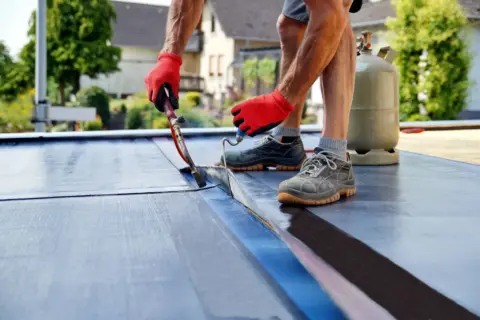How to Transition from Shingle to Flat Roof
When it comes to safeguarding your home, your roof plays a vital role. Over time, shingle roofs can wear down and require replacement. Transitioning from a shingle to a flat roof can be a smart choice, offering numerous benefits such as energy efficiency, low maintenance, and increased property value. However, this is not a DIY project; it’s essential to hire a reputable roofing company to ensure a successful transition. This comprehensive guide will explore how to transition from shingle to flat roof, from assessing your current roof to choosing materials, hiring a professional roofing contractor, and maintaining your new flat roof.
Assessing Your Roof
Before embarking on a transition, it’s crucial to assess your current roof. This evaluation will help you determine if it’s time for a change. Here are some key considerations:
- Signs of Roof Damage: Inspect your shingle roof for signs of damage, such as leaks, missing shingles, or severe wear and tear. These issues may indicate the need for a transition.
- Professional Assistance: A professional roofing company can provide a thorough inspection of your roof and advise you on the best course of action.
- Timing: Consider the age of your current roof. Most shingle roofs have a lifespan of 20-30 years, and a transition might be necessary if your roof is reaching the end of its life.
In the transition process, involving a professional roofing company is crucial to assess your roof’s condition accurately.
Planning the Transition
Planning is a critical phase when transitioning to a flat roof. It involves several essential considerations:
- Choosing Roofing Materials: Flat roofs can be constructed using various materials, including EPDM rubber, TPO, or modified bitumen. Each material has its advantages, so it’s essential to choose one that suits your specific needs.
- Budgeting: Transitioning to a flat roof is an investment, and it’s crucial to establish a budget that includes material costs, labor, and any unforeseen expenses. Visit “How Much Does A Metal Roof Cost In Ontario” for a more comprehensive guide about roofing.
- Project Plan: Create a detailed project plan, including timelines and milestones. A well-thought-out plan ensures a smooth transition.
- Professional Guidance: Consulting with a roofing company can help you make informed decisions regarding materials and budgeting.
Hiring a reliable roofing company is the first step in your journey towards a successful flat roof transition.
Hiring a Roofing Company
Selecting the right roofing company can significantly impact the outcome of your transition. Here’s what to consider when choosing a roofing company:
Licensing and Insurance
Before hiring any roofing company for your flat roof transition, it’s critical to verify their licensing and insurance. Proper licensing assures that the company meets industry standards and legal requirements.
Multiple Quotes:
Obtaining multiple quotes from different roofing companies is a prudent step when planning your transition to a flat roof. It allows you to compare costs, materials, and the scope of roofing services provided.
Expertise:
Roofing materials and techniques for Flat Roofing Richmond Hill require specific expertise. Skilled professionals will know how to navigate challenges related to drainage, insulation, and ensuring long-lasting, watertight results.
References:
Don’t hesitate to request references from prospective roofing companies as you consider your flat roof transition. Previous clients can provide valuable feedback on their experiences with the company, shedding light on their professionalism and the quality of their roofing services
A reputable roofing company is an invaluable asset in your transition to a flat roof, ensuring a successful and stress-free experience.
Removing Shingles
The transition process begins with the removal of the existing shingle roof. This step is labor-intensive and requires careful planning:
- Tools and Equipment: Roofing professionals use specialized tools for shingle removal, including shovels, crowbars, and dumpsters for disposal.
- Safety Precautions: Safety is paramount during shingle removal. The roofing team should follow safety guidelines and use personal protective equipment.
- Proper Disposal: Shingles should be disposed of responsibly, often through recycling or disposal at designated facilities.
Preparing the Roof Deck
A flat roof requires a well-prepared deck to ensure durability and proper drainage:
- Repairing Damage: Any existing damage to the deck must be repaired before installation.
- Insulation and Vapor Barriers: Proper insulation and vapor barriers are essential for energy efficiency and moisture control.
- Level and Smooth Deck: The deck must be level and free of imperfections to ensure a uniform and stable base for the flat roof.
Installing the Flat Roof
The installation of the flat roof is a complex process that should only be performed by experienced professionals:
- Material Choices: Different materials, such as EPDM, TPO, and modified bitumen, have distinct installation methods. The choice depends on your needs and budget.
- Drainage Systems: Proper drainage is critical for a flat roof. Professional roofers will install drainage systems to prevent water buildup.
- Quality Installation: A roofing company with expertise in flat roofs will ensure a precise and long-lasting installation.
Finishing Touches
To complete the transition, consider these finishing touches:
- Roof Coatings and Sealants: Applying coatings and sealants enhances the flat roof’s durability and protection.
- Maintenance: Regular maintenance is essential to prolong the life of your flat roof. Work with your roofing company to set up a maintenance schedule.
Conclusion
Transitioning from a shingle roof to a flat roof can be a wise decision for homeowners seeking durability, energy efficiency, and a modern look. By following the steps outlined in this guide and seeking professional assistance, you can make the transition process smoother and enjoy the benefits of your new flat roof.
Energy efficiency and insulation are within reach when you choose DVR Roofing for your roof transition. We specialize in making your home eco-friendly and cost-effective. If you’re ready to save on energy bills and enjoy a more comfortable living space, contact us without delay. Make the smart choice today and use our expert services to seamlessly transition to a flat roof. Contact us now!
You can also check out our flat roofing services below:
- Flat Roofing Richmond Hill
- Flat Roofing Scarborough
- Flat Roofing North York
- Flat Roofing Vaughan
- Flat Roofing Mississauga
FAQs: How to Transition from Shingle to Flat Roof
How long does transitioning from a shingle to a flat roof typically take?
The transition duration can vary based on the size of your home and the project’s complexity. On average, it may take a few weeks to complete.
Are flat roofs suitable for all types of buildings?
Flat roofs are versatile and can be used for various building types, but it’s essential to consult with a roofing professional to determine the best option for your specific structure.
What are the key maintenance tasks for a flat roof?
Regular inspections, cleaning debris, and addressing minor issues promptly are essential for flat roof maintenance.
Can I install solar panels on a flat roof?
Yes, flat roofs are ideal for solar panel installations, as they provide ample space and easy access for maintenance.
Are flat roofs more susceptible to leaks than shingle roofs?
Flat roofs can be more prone to leaks if improperly installed or maintained. Regular inspections and maintenance can help prevent leaks.


